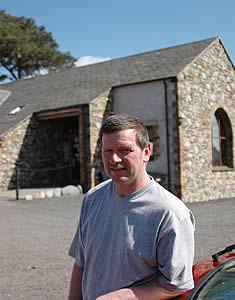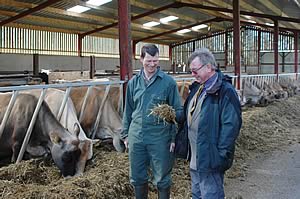17/07/08
A Cumbrian dairy farming family is adding value to the milk they produce by making their own quality ice cream and selling direct to the public.
Leigh Stamper outside the tea room and shop at Wellington Farm.
 |
Self-taught connoisseur of ice cream Leigh Stamper’s ambition took 10 years to come to fruition at Wellington Farm, Cockermouth, and now this business is adding ten times more value to the milk produced compared with that sold on the milk contract.
It was to move out of the family tradition going back three generations of milking black and whites and into Jerseys and the ultimate aim was to produce ice cream and market it direct to the public through a tea room and shop on the farm just off a busy junction outside the town.
After the foot and mouth epidemic of 2001 in which they lost their herd the family had plenty of time to take stock of their future and Leigh, who farms in partnership with his brother Hodgson and father Jim, decided to buy Jerseys.
In February 2003, 110 pedigree Jersey in-calf heifers bought in from Denmark because of a shortage of UK breeding stock started the new herd at Wellington Farm and these were followed by a further 30 imported females along with a bull.
The tea room was opened in March 2005 in a new building designed on traditional lines which attracted a Defra grant, to form the hub of the ice-cream business.
“I was an ice cream connoisseur at an amateur level and I knew what I wanted but I had no experience of making it other than in a small ice cream maker on the kitchen table,” said Leigh.
“Making ice-cream is an exact science even though it is made up of three basic ingredients, milk, cream and sugar. Food scientists helped me with my basic recipe for the ice cream.
“We also knew we wanted to sell the ice cream over the counter and have as much control over our sales as we could. We have had a lifetime of not being able to control our own market.”
The Jersey herd now numbers 185 milkers producing an average 5,800 litres a cow at 6.06 butterfat and 4.20 protein.
Ice cream production at peak times of the year is carried out twice a week, supplying a surprisingly local yet loyal clientèle all the year round.
The ice cream accounts currently for 9,000 litres of the total annual production of more than one million litres, the remainder of which is sold to Dairy Farmers of Britain on a non-Jersey contract for 29.4p per litre.
Alongside the ice cream making, another learning curve has been managing the Jerseys.
The Stampers have found the cattle to be more prone to metabolic disorders and find they respond best to a simple silage-based diet incorporating straw, beet pulp and a ready mixed out of parlour ration.
The winter diet is fed through a feeder wagon to include a flat rate 3kg of concentrate per head and up to 40kg of silage. This is further supplemented in the parlour where the milkers are fed to yield up to 9kg a day.
“The Jerseys have made us with our Promar consultant, Millcroft Veterinary Group and feed merchant Jim Peet Agriculture, look closely at how we were feeding the cattle. It has made us realise that with our black and whites previously we were not feeding for optimum production,” said Leigh.
Yield from forage is at 22per cent with a winter daily average intake of silage at 33kg. Concentrates are fed at an average 0.37kg a litre.
Hodgson Stamper, left, discusses silage quality with seedsman David Baldwin.
 |
“I still think grass is the cheapest feed. I started using high sugar grasses in 2003 on the advice of the specialist seedsman we have been consulting over the last 38 years, David Baldwin,” said Leigh.
“I didn’t know much about them but they do get results. The particular field we sowed was also a pathway to other grazing ground which we paddock graze for a week at a time.
“When the cows were taken through the high sugar grass field we couldn’t get them off it even though there was up to five inches of grass in the grazing paddock beyond it.
“We noticed that every time the field was grazed we had up to an extra 150 litres a day. That was even when the cows were grazing the silage aftermaths. The grass is very leafy and we notice the bulk when making silage.”
The original field, sown with Formula 3, a long-term cutting and grazing mixture consisting of three diploid and one tetraploid high sugar grass varieties, Timothy and a white clover blend, is still productive. The policy is to re-seed when necessary.
Since 2003 all the re-seeds on the 270-acre all grass farm have been the same high sugar grass mixture, accounting for more than 90 acres. Currently there are no intentions of using other mixtures.
Re-seeds are usually made after the last cut of silage – last year because a plentiful supply was left from the previous winter, only one cut was taken.
After burning off the field, it is ploughed and sown by contractor and Leigh said the mixture established very well.
The swards are grazed initially but are also used for silage ground. Last year’s cut taken in early June analysed at 38.7 per cent dry matter, 12 per cent protein66.1 D value, 10.6 ME and pH 4.4 – a poorer crop than usual because of the need to wait too long for dry weather.
In the diversified venture, Leigh is in partnership with his wife Gill, Hodgson and his wife Susan. The farm business employs one worker, Matthew Fisher, who is a Jersey enthusiast, while the shop employees five full time and three part time staff.
Their respective families have found work away from the farm. Leigh and Gill’s oldest son Clinton is an electrician while Rowen is a plumber. Hodgson and Susan’s daughter Ashton works in the tea room kitchen while their son Kyle is a gold and silversmith.
As the business develops, Leigh envisages possibly reducing cow numbers and using as much of the milk as possible for ice cream making.
Wellington Farm has also been put on the map by another venture, although purely for charity, driven by Clinton and his fiancée Debbie, and an enthusiastic committee.
What started out as a small party to raise money for the air ambulance after a friend was left paraplegic after a mountain bike accident has now turned into an annual rock festival attracting thousands of people and this year’s two day Cockrock event on July 19 and 20 is expected to be attended by around 8,000.
 Beef Shorthorn - a Breed for the Future Beef Shorthorn - a Breed for the Future
 Pedigree Texel Sheep Flocks Mean Business Pedigree Texel Sheep Flocks Mean Business
 Barn at Beal Visitor Centre Sheds Light on Farming Today Barn at Beal Visitor Centre Sheds Light on Farming Today
|




